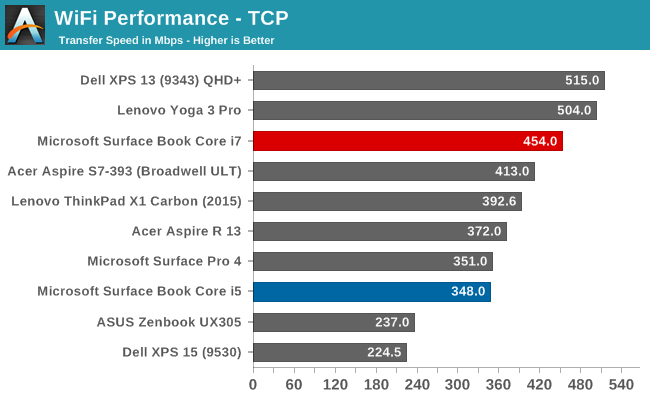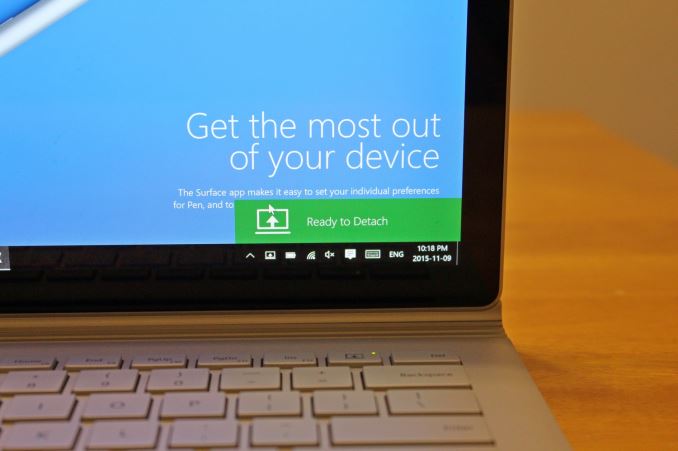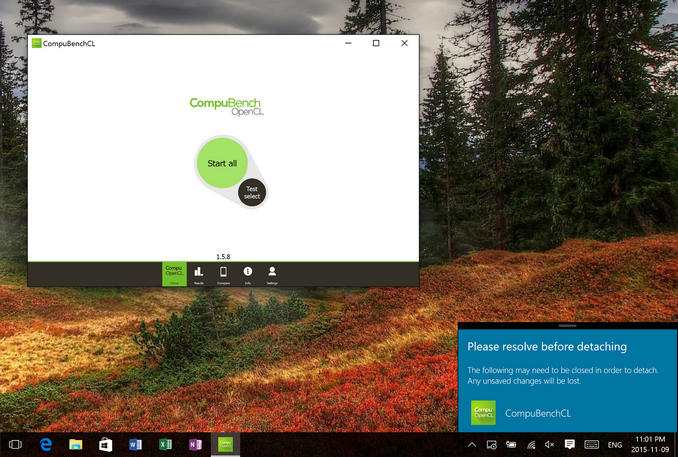The Microsoft Surface Book Review
by Brett Howse on November 10, 2015 8:00 AM ESTWireless
Microsoft continues to employ the Marvel AVASTAR network adapters, which have been somewhat of a sore spot over the years. They have made a lot of driver updates though, and I’ve not run into the issues that used to plague these devices. They also have not historically been the fastest network adapters around, usually averaging around 350 Mbps on a SMB file copy.

The Core i5 model hit exactly what I expected, but there was recently a couple of firmware updates for the Surface Book. It seems to have made some big improvements because the Core i7 model is hitting speeds that I’ve never seen out of these cards. By the time I recieved the updated firmware I no longer had the Core i5 model, but I did update the Surface Pro 4’s firmware, and although I didn’t get quite as good of a result, it was still 50 Mbps higher than when it was first tested.
Speakers
The Surface Book continues to make use of two front facing stereo speakers, which are almost invisible in the bezel. I really like the design that Microsoft has gone with. Many Ultrabooks go with downward firing speakers to save space, but because of the Clipboard, Microsoft would not be able to go this route. They have stuck with the same design as the rest of the Surface lineup, and to great effect.
The Surface Book was able to hit about 80 dB(A) playing music, and for a 7.7 mm thick tablet, the sound quality was good, with decent low end response. Any serious listening should still be done through headphones though. I’ve seen a couple of issues raised with the headphone connector on some of the pre-release Surface Books, but the Core i7 model has exhibited no issues at all. Headphones sound great.
Experience - Room For Improvement
I was going to call this section Software, but it’s more than just software. It’s also not all good, but there’s been some news on that front as well.
Let’s get the bad news out of the way first. The Surface Book has not been a 100% trouble free experience. There have been a lot of issues reported, and many that I’ve experienced as well. Let’s start with the reason this review is delayed in the first place. The first unit that I got had a keyboard failure on the second day. Neither the keyboard nor trackpad would function at all, and it was not even detected in Windows. To be fair, this was a pre-production unit, and Microsoft has not seen any other failures of this type when last I checked with them. But I’ve seen other reports of the keyboard not working after the Clipboard is re-attached, and you either need to restart, or remove the Clipboard and try again. This is likely a software issue similar to the Surface Pro where it sometimes needs the keyboard removed and re-attached to get it to function.
Battery life, which I’ve already mentioned, has been poor when the device is in sleep. I’ve also had issues when it is awake though, causing high levels of draw once in a while. This seems to be more of an issue with the dGPU model, but the non-dGPU model was difficult to use for long periods of time with the non-functioning keyboard so it’s difficult to judge that model. Windows Hello can also cause issues with sleep.
There have also been issues with the screen changing hue, and flickering. Luckily these issues have been sorted out with a recent firmware update which installed a new graphics driver. I haven’t noticed them at all since, and they were very annoying before.
Meanwhile out of the box, the Surface Book is set to not switch to tablet mode automatically, nor is it set to prompt you to do this when you detach it. You have to go into the action center and manually enable tablet mode. I thought this was odd, so I changed it to automatically switch and not prompt me. This was a mistake. Randomly, the device would just switch to tablet mode. It seemed to be detecting that it was detached for brief moments and making the switch.
I’ve also seen reports of people unable to detach the top, but that I have not run in to.
The good news is that the firmware update released on November 2 has done a good job on a few of these bugs. Issues that were major problems are gone. I fully expect this to continue, but at the moment, there are still outstanding issues with the Surface Book. Microsoft is hard at work trying to get the other bugs sorted out, and expect more firmware updates soon, but for the time being the software side feels a bit rushed.
With that out of the way, let’s look at the software that is available. Since this is a device from Microsoft, you get zero bloatware installed. Booting the Surface Book has just three pieces of software listed in the Startup section of the task manager: OneDrive, NVIDIA Update, and Surface DTX. OneDrive is pretty self-explanatory, and the NVIDIA Update is not actually updating the drivers, but rather the whitelist which enables the dGPU. The interesting bit is the Surface DTX.
If I had to guess, DTX would stand for Detach Tablet Experience, but that’s a guess. This is the small piece of software which lives in the system tray that actually performs the Clipboard detach. On the non-dGPU models, this is as easy as triggering the muscle wire to unlock, and then notifying you on-screen with a “Ready to Detach” message. When you clip back in, it shows a message of “Attached” so you know you are good to use it as a notebook again.
When you have a Surface Book with a dGPU though, this all changes. The DTX software monitors if the dGPU is in use. If it is, the icon in the system tray changes to let you know. If you try to detach when the dGPU is in use, it will pop up a box letting you know that you can’t detach, and which program needs to be closed to let the dGPU be released. Software doesn’t normally deal with an instant hardware loss, at least nothing like a GPU, so this is a pretty smart way to get around having applications crash when trying to detach the clipboard.
If you want to change which GPU is used for a program, you have a couple of options. You can set the global setting from Auto-Select to either GPU using the NVIDIA Control Panel. This is easiest to find by searching Start for NVIDIA. You can also customize which program opens with which GPU using the Programs tab, just like with any Optimus machine. The final way to choose is to right click the shortcut to the program, and choose “Run with graphics processor” in the right click menu. Anyone who is familiar with Optimus will find nothing out of the ordinary here.
Generally, devices with NVIDIA graphics have the GeForce Experience software installed as well, but Microsoft has chosen not to install this out of the box. You can install this from the web though, and it will give you the features, such as the ability to have the GeForce Experience select the settings for a game to maximize performance versus quality. If you intend to do a lot of gaming, you may want to install this.
For those looking for more information on the Surface Pen, it's the same model as the Surface Pro 4, so rather than re-write the same text, please check that section out.












249 Comments
View All Comments
s.yu - Sunday, November 15, 2015 - link
Many ultrabook displays cover the same color gamut with just as good color and greyscale Delta E They're calibrated, they just don't advertise it so much. You're fooled by MS. As for 13.5" 3:2, 14" 16:9 is similar and you could get more done on the new XPS15's 15.6" screen, with more screen and less bezel.450nits, yeah that's unique, however quite useless. It's like Xperia Z4's ~800nits panel, nobody needs that much and sunlight visibility ends up slightly worse than S6's panel which topped at ~600nits. I just got a new panel for my notebook because the old one leaked liquid crystal. It's much brighter and sometimes seemed too vibrant (I admit it's 95% AdobeRGB) when displaying some saturated colors, which reminded me how much the old one's backlight aged in 3 years, but when I calibrated it, Spyder showed that it was only 194nits, I couldn't believe it as I was almost sure it's over 250nits just looking at it with my bare eyes, so I'm positive that I'll never need anything past 250nits on a notebook.
The narrow gamut on the MSB however, couldn't be made up for.
ninjacut - Tuesday, November 10, 2015 - link
After coming from Dell, Lenovo, HP I always wanted Microsoft to build their own laptop. So the Surface Book announcement was very exciting.The good technical part was covered well by Anandtech, with some gaps around pen, etc. with some obvious Apple bias creeping. But I don't agree with the conclusion. After the Nov 2 update, I have no issues with the unit. On the contrary, having used the device last 2 weeks made me realize how productive this device is.
I am impressed with the keyboard, touchpad, pen very superior to any earlier experience. The display is awesome in size and richness. Biggest surprise was how light is the display unit in tablet mode, hard to realize it has a Core i7 running with 8GB and 256 SSD.
In one of my recent meetings, I just removed the display and handed over to the client to go through some dashboards and he was flabbergasted. The meeting turned out very positive.
This unit is a keeper, and if the updates come in regularly I never will buy any other OEM laptop for sure
Cobalt Wraith - Tuesday, November 10, 2015 - link
Dito, in the same book and have not encountered any of the allegedly prevalent problems.s.yu - Wednesday, November 11, 2015 - link
Go on Amazon to read the amazing number of 1 star reviews. Some complained a great deal but gave 3-4 stars out of decency.solipsism - Tuesday, November 10, 2015 - link
1) I'm glad to see that the trackpad feel and firmware is decent.2) I don't know if it comes to down to a lack of volume or a lack of expertise, but MS's horrible use of space on their logic boards repeatedly wastes a shitload of space that could reduce the device volume, reduce the weight, and/or allow for a larger battery.
nikon133 - Tuesday, November 10, 2015 - link
Leaving space for next gen improvements? :)nerd1 - Tuesday, November 10, 2015 - link
Returning mine soon. May get thinkpad 460 instead.Teknobug - Tuesday, November 10, 2015 - link
Got my eye on HP Spectre x360 or Dell 13 7000, but saw the Yoga 3 Pro too.nerd1 - Tuesday, November 10, 2015 - link
x360 is a really nice device. Good build, nice screen (even 1080p), good keyboard and big battery. I don't like the weird trackpad (still usable though) and garbage synaptics pen though.It will be great if HP release a new x360 with 3:2 screen and wacom AES pen. I'd gladly pay $1500 if they make one.
GeorgeH - Tuesday, November 10, 2015 - link
I'm going to be "that guy".1) Not putting any information about the competing laptops (esp. CPU) makes the performance comparisons almost completely worthless, especially when you consider how sensitive U-series CPUs can be to their thermal solution and firmware configuration. I could of course assume that they are specced as tested in previous AT reviews, but why should I be doing that work?
2) A “bunch of battery” doesn't just disappear (conclusions). Either the battery life indication is bad or you’re not properly conducting/controlling the test. The fact that the Book’s fans became audible and very hot when closed makes me guess that Windows detected an idle state and was doing background tasks. That further tells me that the tests probably weren’t properly controlled and have significant margins of error.
3) I understand you no longer have review models in house, but there’s absolutely no mention of different Windows versions (or CPU/hardware differences) in your battery life tests (I know Win8/10 are almost identical, but still). Could the Book’s superior life be due to Windows 10, OS optimization work Microsoft did specifically for the Book, generational CPU improvements, or something else? Any of those could have been addressed and/or tested for, but instead we get an insipid “dunno, GDDR5?” statement. When we consider the fact that the GPU is undockable and that this device is therefore uniquely capable of a rough analysis of how adding a discrete GPU affects laptop battery life, that kind of “hell if I know” statement is even more ludicrous.
This was an OK review when compared to the raft of “long forum post” reviews available elsewhere, but very disappointing in relation to what I expect from an AT review.